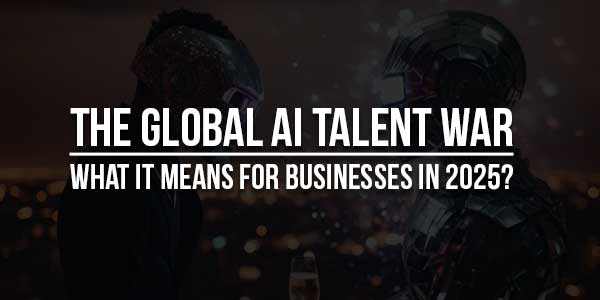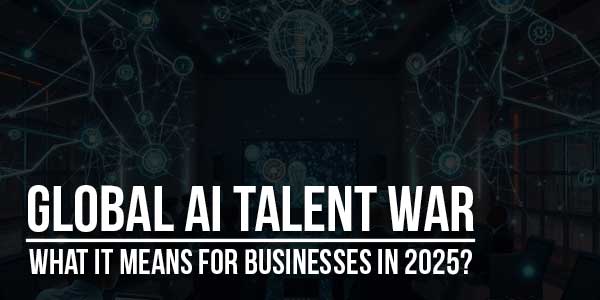
Artificial intelligence (AI) has become a leading driver for modern trade strategy from a future concept. In industries, companies utilise AI to improve efficiency, innovation and competitive advantage. But the most important feature of the algorithm and the data model is: Talent. As of 2025, global competition for skilled AI subjects has reached outstanding levels. This so-called AI Talent War is based on how businesses are hired, innovative and on scale; both opportunities and challenges create opportunities and challenges.
Table of Contents
Why AI Talent Has Become the Ultimate Resource?
In the digital economy, data is often called “new oil”, but talent is what refines it. The AI systems are only as powerful as the developers, engineers and researchers who build and adapt them. As businesses have driven to machine learning, natural language processing and generative AI, the demand for special skills affects the sky.
The AI experts are in low supply globally, concentrated in parts of North America, Europe and Asia, and the most effective professionals. Emerging economies are eager to catch up, but training pipelines and infrastructure are often backwards. This imbalance leads to a global persecution for AI expertise, making it a defined factor for competition. Companies seeking to hire AI developers should not only navigate the increasing wage expectations, but also a hard -competitive market, where talent is located aggressively on boundaries.
Drivers of the AI Talent War:
Several factors have accelerated this race for talent:
1.) Rapid Adoption of Generative AI:
The increase in generic AI tools in 2023 and 2024 proved how AI could be transforming industries. In 2025, companies no longer experiment – they operate AI on a scale. From marketing to chain optimisation, each department seeks AI integration, and requires driving for skilled professionals who can distribute and maintain these systems.
2.) Global Investment in AI Innovation:
Governments and private investors are channelling billions into AI research and development. The United States, China and the European Union are particularly aggressive, creating a wave effect worldwide. This investment fuel similar to startups and businesses, competing for the same limited pool to AI researchers and engineers.
3.) Expanding Business Use Cases:
AI is no longer limited to technology companies. The health system, finance, agriculture, logistics and even creative industries involve AI in daily tasks. This expansion increases the demand for talent beyond traditional technology sectors and intensifies competition.
4.) Scarcity of Specialised Skills:
General AI knowledge becomes more widespread, but high-level competence is rarely in areas such as learning, large language models, moral AI and AI infrastructure techniques. Companies require niche skills, which are even more difficult to find.
How Businesses Are Responding?
The war for AI talent has forced organisations to assess recruitment, compensation and storage strategies again. Companies are using many approaches in 2025:
Offering Competitive Salaries and Benefits:
Top AI engineers commanded the wages of these officers’ rivals. Companies also increase the benefits, such as flexible work schemes, opportunities for research budget and career development to maintain talent.
Building Global Teams:
External work and global hiring platforms allow companies to use talent beyond their domestic countries. Companies are quickly open to distributed teams, although there are challenges in management, communication and data security.
Partnering with Universities and Research Institutions:
To create a pipeline of future talent, many organisations work with educational institutions. Providing sponsorship research, financing grants, and internships is a strategy for attracting new AI professionals quickly.
Acquiring Startups:
Instead of competing in the open market, some companies provide small AI startups. This not only protects intellectual property, but also absorbs the entire team of talented developers and scientists in one step.
The Role of AI Development Companies:
By 2025, many organisations believe that they cannot build internal AI teams that are enough to meet the requirements. This has increased the role of the AI Development Company as a strategic partner. These companies provide special expertise and prepared teams, so that companies can accelerate projects without delay.
AI development companies also bring insights into the cross-industry when working on different projects. This experience enables them to use lessons in different fields, and often leads to more new solutions than internal teams. Especially for small and medium-sized businesses, partnerships with external experts are a cost-effective way to keep up with AI change.

Challenges Businesses Face in the AI Talent War:
Despite creative solutions, the AI talent shortage brings significant hurdles.
Rising Costs:
The bidding war for professionals inflates salaries and operating expenses. While large companies can absorb these costs, startups and small businesses often struggle, causing inequality, which can be addressed by using advanced AI systems.
Risk of Talent Hoarding:
Some organisations prioritise hiring AI professionals even without immediate projects, simply to expand the scope of the participants. This leads to incompetence and contributes to the problem of deficiency, as talent focuses on smaller organisations.
Ethical and Regulatory Concerns:
Governments quickly examine the AI development for bias, openness and moral standards. Companies should not only offer innovative solutions to their teams, but also comply with developed rules. Compliance-oriented AI talent deficiency combines complications.
Employee Retention:
Maintaining AI talent is definitely more difficult than recruitment. With continuous proposals from the participants, employees can often be banned from changing jobs. This churn disrupts project continuity and slows innovation.
Emerging Solutions to the Talent Shortage:
Despite the challenges, businesses are exploring strategies to ease the talent crunch.
Upskilling and Reskilling Programs:
Forward-loving organisation, AI skills are being trained in existing employees. Although it is not a complete solution, this approach expands the internal talent pool and reduces the dependence on external prices.
AI-Driven Recruitment:
Ironically, businesses are turning to AI to solve the hiring challenge. Machine learning tools can quickly identify appropriate candidates, assess skills more accurately and predict the probability of retention.
Open Source Collaboration:
The open-source AI community plays an important role in talent development. By encouraging collaboration, developers build skills and contribute to global innovation, making the ecosystem more dynamic.
Global Policy Initiatives:
Governments and international bodies start policies to promote AI education, the dynamics of skilled professionals and moral frameworks. The purpose of these initiatives is to balance competition with long-term stability.
What Does This Mean for Businesses in 2025?
AI Talent War is not just a recruitment issue – this is a business strategy challenge. Companies that are unable to secure talent risk in innovation, losing their innovation lead to rivals. On the other hand, AI can attract, maintain, maintain or achieve successes in business efficiency, product innovation and customer engagement.
For leaders, the message is clear: The ability to take advantage of the AI talent is now as important as capital or technology infrastructure. In addition to recruitment, companies should focus on creating cultures that induce creativity, promote continuous learning and balance moral ideas with performance goals.
The Future Outlook:
Looking forward, it is expected that many trends will form the projection of the AI talent war. AI will make the democratic tool more user-friendly, so that companies can reduce less on deep technical experts for regular tasks, although advanced competence will still be important. Global cooperation will probably also play a role, as borderline participation in education and innovation helps to reduce the lack of talent. At the same time, automation of AI development can reduce the dependence on rare experts; AI can help in parts of its own construction. Finally, increasing high of rules and responsibility will promote demand for skilled professionals in moral and responsible AI development, making it a main qualification for the future.
Conclusion:
Global AI Talent in 2025 is a defined force in the war for business scenarios. Organisations compete fiercely for a limited pool of experts who can drive innovation and development. Although there are also new ways to succeed in challenging costs, from cost-to-promotion risk, including partnerships, apasming and AI-operated recruitment.
Finally, effective navigation companies will not only secure the best minds but will also unlock the entire AI capacity. Those who fall behind can exclude themselves from the next wave of technological change. Over the coming years, talent will be a decisive factor in separating AI leaders from Lagard in the global economy.

 About the Author:
About the Author:
















Be the first to write a comment.